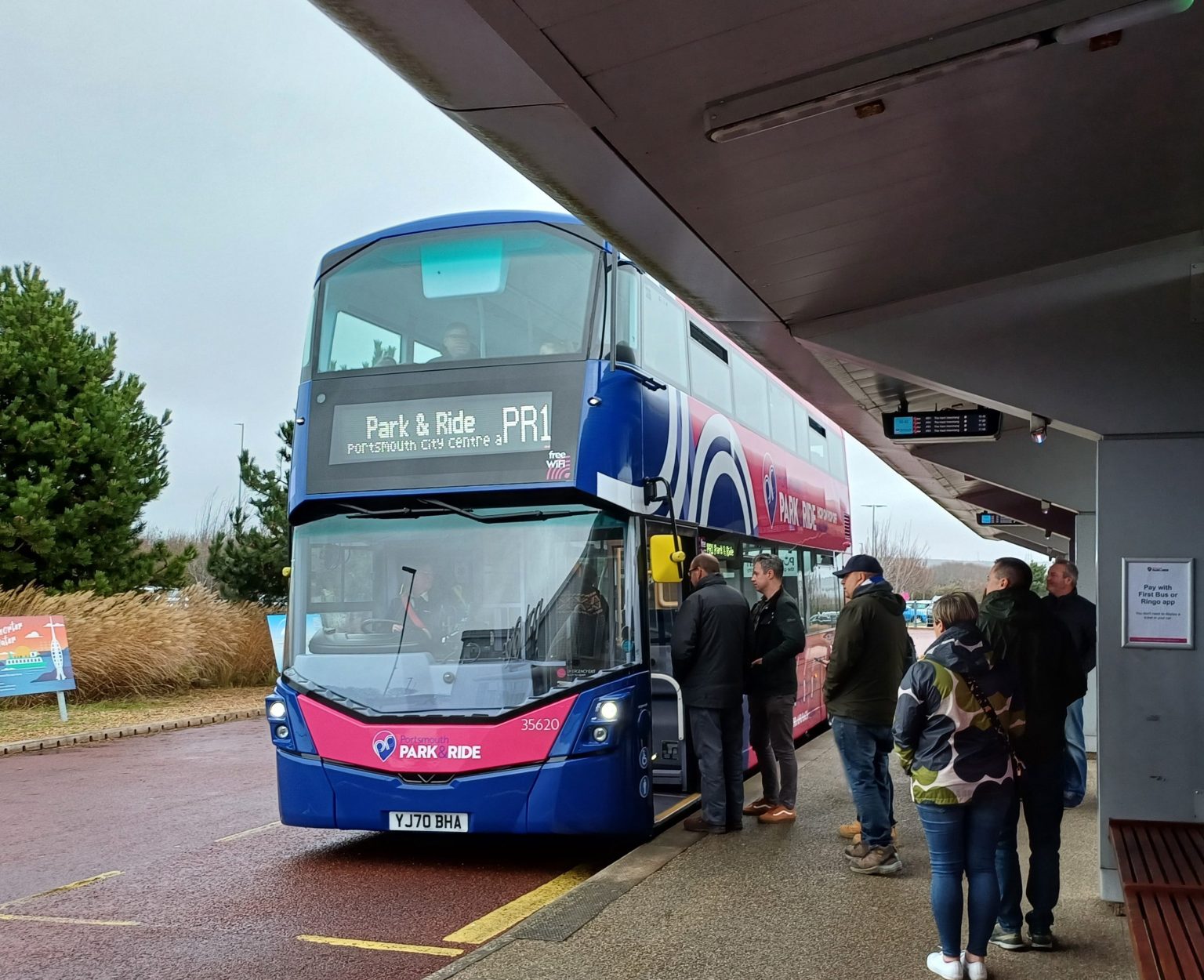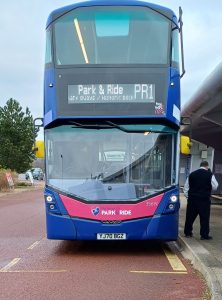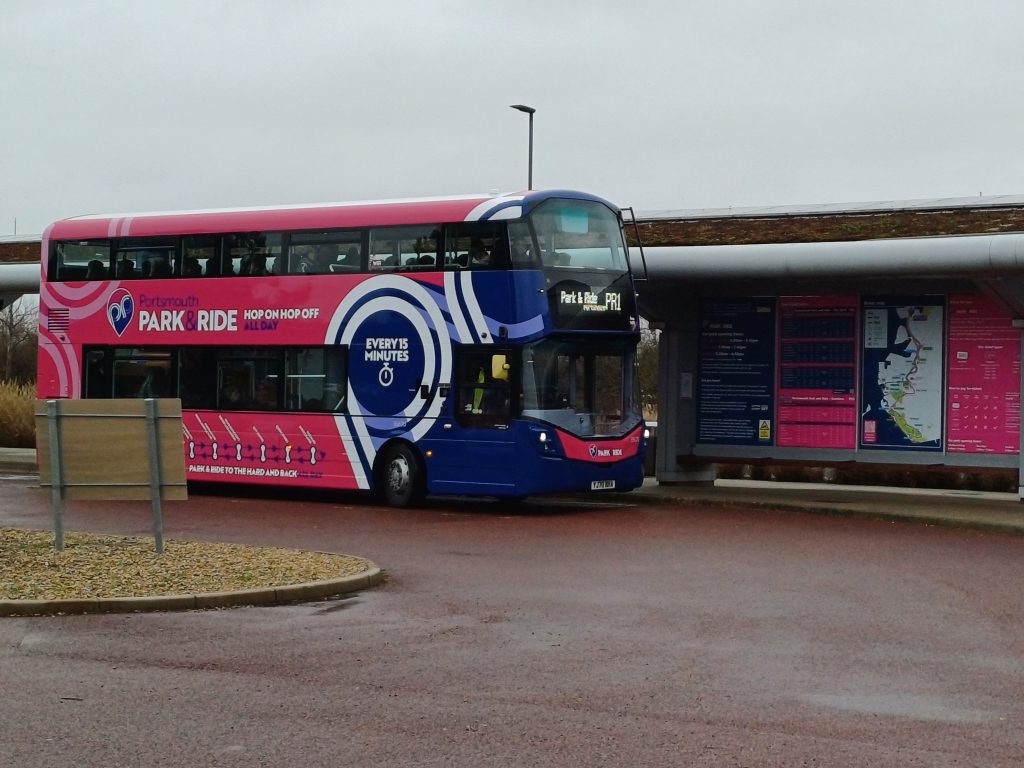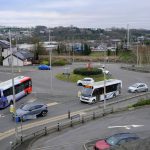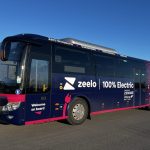In January, Portsmouth, grappling with a park-and-ride whose patronage had been slow to return post-pandemic and which suffered with funding challenges and insufficient promotion, announced a reimagining of the service to meet the challenges of a changed urban landscape.
An evaluation and relaunch has broken what was described as a ‘cycle of declining awareness and commercial viability’ by council representatives. With an all-new blue and pink livery for the two buses on the service, better advertising and enhanced ticketing options to improve convenience, Portsmouth’s park-and-ride is already finding renewed purpose in intercepting motorists and appealing to new visitors to the city.
Park-and-ride comes first
Unusually for a local authority, enabling the park-and-ride in Portsmouth has been described as the ‘first policy’ for the attention of council officials. The city has a mandated Clean Air Zone and so the park-and-ride acts as a tool to reduce congestion. It forms an essential part of its local transport plan, its Enhanced Partnership, and the associated improvement plan undertaken with the city’s bus operators.
But why was it failing?
According to Paul Walker, Head of Passenger Transport at Portsmouth City Council, the old park-and-ride had been dedicated to city centre office staff. It had enjoyed strong patronage, but a year on hiatus through COVID-19 lockdowns and changes to travel patterns led to a considerable decline in ridership among its core market. Correcting that decline has been essential to reducing the service’s deficit to the council; the intention is to halve it within the next two to three years.
Through new ticketing technology, the local authority was able to identify customer demographics and swings. A survey of non-users gave a further picture of where the market was failing, revealing that 94% of current customers had been using the service for over a year, indicating strong retention, but that only 6% of respondents were recent adopters (within the past year). That meant a need to target new users, while capitalising on high retention rates. Work began with city stakeholders to look at how their services could be promoted within a repositioned service that had leisure as its core offering.
“We wanted to reposition this to refer to the fact the world has changed, people aren’t returning to the office five days a week,” explains Paul. “There are a lot of changes in city centres and post-COVID there’s been a big shift towards experiences. This renewal was to facilitate what we saw as a permanent change but also to sweat the asset. The tourist days start later and are every day of the week. Commuter days are five days a week — we can do what we’re doing now, but it doesn’t affect our ability to also work the commuter market.”
Smoother experience
Portsmouth City Council targeted a customer-centric approach focused on convenience, cost, travel time, and social impact.
One barrier to new users had been a requirement for tickets to be purchased on foot, before boarding. On-bus payments were added as an option, and more emphasis was placed on how often the service ran, and where it stops within the city centre.
Getting motorists on board as ambassadors proved to be a huge boon. By removing outdated on-foot ticket machines and migrating users from physical smart cards to an app it removed the risk of passengers missing their service, while making the entire experience smoother.
Portsmouth City Council also expanded the service’s reach through advertising and ensuring visibility to those outside of the city. Sarah Jones, Bus Service Improvement Plan (BSIP) Project Manager at Portsmouth City Council notes that, by extending the area of search promotion and making visible to people outside the city that the service was easy to use, patronage among the likes of retail shoppers and contractors increased.
‘One-team’ working
Ensuring the relaunch went smoothly required a new way of working between local authority and operator First Bus.
Paul notes that interaction between the two teams had before been contractual. Now, a much closer approach has been adopted. Even the drivers know the local authority leadership well.
“Although it’s the same service provider as before, we have created a one-team philosophy,” Paul says. “We deal directly with the commercial team at First, so we know what’s happening in terms of ticket sales; they’re part of the programme board every month. We are quite clear and go in one direction as a partnership to grow.
There is no commercial incentive to grow passengers, but they want to grow passengers as part of the partnership because it has wider impacts and improvements for them, such as less congestion and better bus reliability, and it’s a good thing to do in terms of growing the market and promoting the city.”
That partnership has also meant better working to address KPIs, service improvements, maintenance downtime and lost mileage.
“We’re a team that delivers and we can show results, that’s why our overall journey numbers [in Portsmouth] are the best for city recovery in England; our patronage increase last year was 24% year-on-year bus use growth.“ says Paul. “We do that through working with our operators and giving them confidence; by acting as one collegiate team that delivers together and that can have difficult conversations and an element of understanding.”
Portsmouth’s park-and-ride positions itself now as a sister to the emerging Portsmouth Buses brand. Some work remains to be done on bus stops, flags and shelters, all being undertaken within the city’s BSIP. December 2024 saw an eight-year high on patronage, beating pre-COVID numbers, and the hop-on, hop-off facility within the city has seen usage rise too.
CAZ-compliant diesel has been specified in the tender for now, but electrification is a future ambition; upcoming campaigns will focus on educating the public about the health benefits of reduced pollution. Success will be measured through annual surveys, with an ambition to see a ‘10% increase in health-conscious users’ choosing the service as their travel option by year five.





















